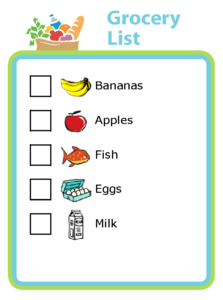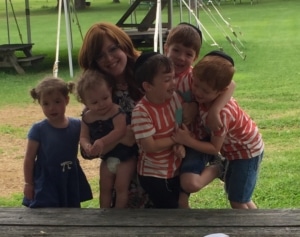No, I don’t mean my son, he’s only 6. I mean my husband. And by alone, I meant without me, he did have the kids. All five of them.
The one who doesn’t stop talking, the one who doesn’t stop touching, the one who doesn’t stop tripping, the one who gets overwhelmed by stimuli, the one who doesn’t stop whining as well as the one who keeps jumping out of the cart 🙂
But I wasn’t going to send him in defenseless, I know my children and their needs! And most of all, I had done the “going into the community” thing with many clients, and have experienced the pitfalls and obstacles firsthand, and I was going to give my husband the benefit of a behavior plan with antecedent interventions as well as consequences set up.
But I wasn’t going to send him in defenseless, I know my children and their needs!
First thing I did, the night before the “big trip” was prepare a short social story about grocery shopping. Now, all of the children had been grocery shopping before. This was just highlighting the behaviors we wanted to see and those we did not. I made sure to write about our planned “shopping game” in the social story, to be read prior to heading out to the store.
Next, I prepared the “shopping game.” Pretty much what I did was print 5 different shopping lists, one for each child. For the baby, who would most definitely be upset if she wasn’t holding a paper, I just printed out pictures of random food. For the 2.5 year old, I put a picture of 5 apples and a box of cereal (this would keep her busy throughout a couple of aisles, I hoped). For the 4 year old, I had a couple of other items, such as pasta, plastic forks, another cereal, and a stalk of celery. I had about 10 items each on the 5 and 6 year old’s lists. I laminated the lists at home, and velcroed on a dry erase marker. And then, as I know my children, and most children, will want every treat in the store, I attached a sticker of a treat at the bottom of each list- you finish your list, you get a treat! This would function as the reinforcer. Part 2- done!
I wasn’t going to just hope this would be enough. Just to be sure no sudden problem behavior erupts, I packed a small bag with pretzels for each of the small children. If the stimuli were too overwhelming, if the line at checkout was too long etc, at least their mouths would be busy 🙂 This served as our NCR- Non-contingent Reinforcement piece.
And he was set! I left to work early the next morning, confident they would do fine.
And he was set! I left to work early the next morning, confident they would do fine.
And they did. My husband read the social story at home before they left and reviewed the game. They piled in and around the shopping cart and received their shopping lists, and the trip began! The kids had a great time finding the items they needed, they all felt involved, the babies were well fed (the baby needed her pretzel bag very soon after entering the store lol), and the big boys spent time debating the merits of the chocolate vs the taffies as the reinforcer when they were done, but did not ask for every treat in the store! Altogether, a success!
Before heading out into the community, it may be worthwhile to prepare ahead of time:
- Do a mental walk-through of the entire trip. Mark down possible obstacles you and your child may face.
- Analyze what function the obstacles serve. For example, if your child is going to be grabbing items off the shelves, try and figure out if he is doing that as a call for attention, to access a tangible, as an escape, or maybe because he is in sensory overload?
- Once you have a possible function, try to find a replacement behavior that serves the same function. So if your child is throwing a tantrum because he wants a specific candy, have it for him in advance, or make it possible for him to get one before the end of the shopping trip. NCR works wonders for this 🙂
- Social stories do work! They don’t work for every child or for every situation, but if a social story is appropriate for your child, write one and read it in advance. It is always good for your child to know what to expect on any given outing.
- Keep it short! Don’t go in for a complete restocking, especially for the first few times your child joins you. Keep a short list and be prepared to leave without it should a situation arise where you need to leave.
These basic principles can be applied to any community outing. Get out and have a great time!!




